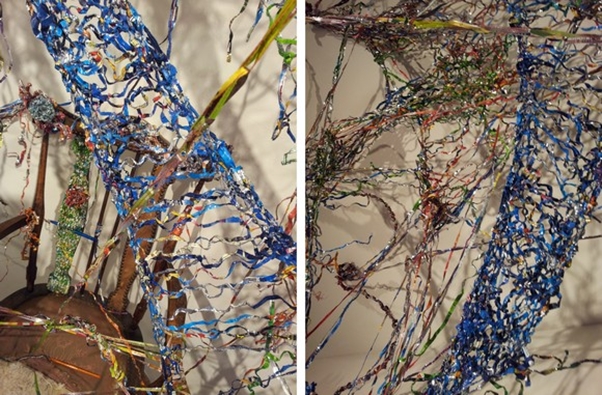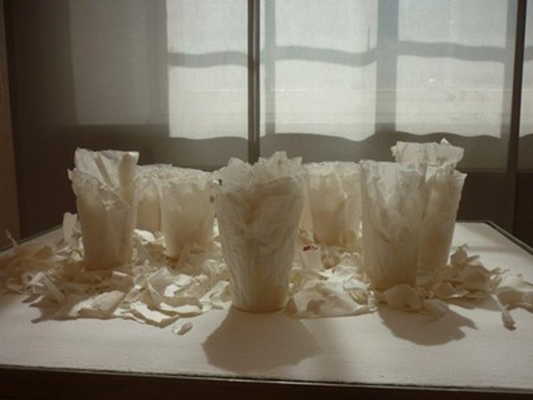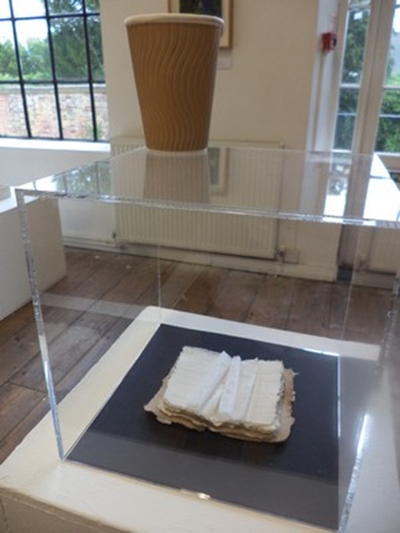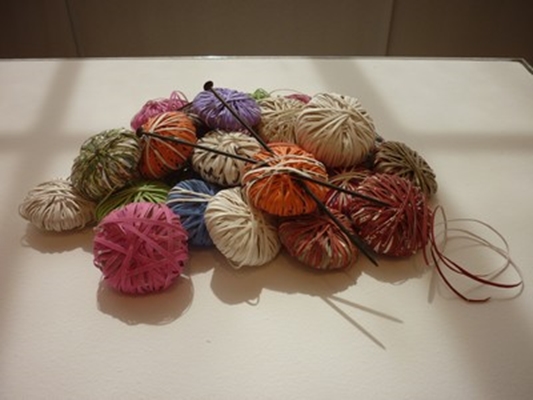Sustainability Innovation and Activism
Alison Harper
Deeper and Deeper?
Deep ecology, deep craft and ecofeminism
I feel the writing of this paper very much brings my life full circle if you like; when I first left school I went to university to study sociology. I didn’t last long and was soon back at home applying to go to art college, from which I had been dissuaded. I was accepted and have lived a pretty creative life ever since, through one means or another. To research and write this paper has been both a challenge and a privilege. I have had to reflect on and examine my own creativity, the reasons why I make and how I can communicate this to others.
The last few years have seen a change in attitudes towards, and interest in, making; its benefits and the wider societal implications. In this paper I will attempt to link this interest with a deeper investigation into the ethics of making and why it matters.
This paper will examine some concepts and ideas that are easily said and easy to think we understand. This will explore ideas around definitions; definitions of ecology and deep ecology, craft and deep craft. I will also examine links to the feminine through looking at ecological feminism or ecofeminism.
I will begin by discussing some of my own work and current practice as a textile artist researching, by means of a practice based Phd, issues of sustainability and the meaning of making; and why we must make the move from materialism to materiality.
My own work is about resources; I rethink, reimagine and rework commonly used materials and objects that are used once and discarded. These materials slip, almost unfelt and unnoticed, through our hands; distanced by a veil or a shield of familiarity from their origins, before entering ‘the waste stream,’ a poetic term meaning landfill.
This intention of only being used once is therefore interrupted, and indeed disrupted, by a looking again, a rescuing and a gradual re-instatement takes place. I give these materials a new lease of life, placing them into the elevated realm of ‘the hand-made’; belying their mass-produced industrial origins. This is a privileged yet disputed place at the same time revered and yet not valued or fully understood by our culture. I am questioning our right to use these materials for our own purposes in such a disdainful and perfunctory way. How great is that ‘need’ or is it more a convenience and how does this ‘need’ balance or justify the equation of usefulness to humankind with the ‘using up’ of resources and energy?

The images above are of found crisp packets; I find them everywhere, and in wanting to make something ‘useful’ from these materials, have discovered that they can be made into a kind of yarn – each bag yielding between 5 and 6 metres. I cut and stitch; a slow domestic process using scissors, thread, a sewing machine. I can then use this yarn to experimentally knit, crochet, improvise and engage an audience in an art installation, sometimes, but not always, gallery-based. I invite participation from my audience so that the work becomes a collaborative process.

I am encouraging a reassessment of these materials, often unrecognised by this audience, whose main concerns are often how much time this must have taken me and, on discovering their origin, did I wash the bags first? Subjects for further research, perhaps.
I want to use and highlight these materials, not through any particular affinity felt with this material but because I see this product as being exploitative in terms of resources (they are made of a kind of plasticised aluminium sandwich which cannot be ‘recycled’), and also of people (an unhealthy, superfluous food which through clever marketing has become a staple of lunchboxes throughout the land).
Britons eat 6 billion packets a year; more than 11 million packets per day are produced at the Walkers factory in Leicestershire. Walkers have a 47 per cent share of the British crisp market. I.
One third of children in the UK eat crisps every day.2.

Paper coffee and tea cups are another single-use product that has come under my scrutiny. These ‘paper’ coffee cups, do actually have a lining of plastic, of polyethylene, making them impossible to recycle. This was discovered by peeling away the outer layer of paper to reveal this inner hidden layer.

With the paper fibre I make a pulp and use it to make other objects, in this instance a book; this piece is called ‘Book of Knowledge’ and has thirty six ‘pages’ as well as a front and back cover. It uses every part of the cup, just like the one resting on top of the perspex box. There is a surprising amount of paper pulp in these cups as it is so compressed in order to make the cup more waterproof. It has to be made of mainly virgin pulp due to health regulations. Paper cups were originally developed at the beginning of the twentieth century to prevent the spread of disease, at a time when people shared drinking cups and glasses at public supplies of drinking water.
The last image is of cut cups, just cut with scissors, and wound around the base of the cup; a material full of potential ready to be made into something else. So again the intention with this work is to demonstrate how much ‘unnoticed’ material there is in these objects.

It is estimated that in the United Kingdom 2.5 billion paper cups are thrown away every year.3
Deep Ecology
Arne Naess 1912- 2002
Arne Naess coined the term deep ecology in 1974, in the process distinguishing it from ecology as a branch of science or biology.
Arne Naess was a climber, a man of the mountains. He would live in an isolated mountain hut at certain times of his life, using it as a retreat where he would study and write. He was a philosopher, activist and teacher. He had become a professor of philosophy at Oslo University by the age of 27 and is still a man much revered in his native Norway. Naess resigned his professorial post to solely pursue ecological concerns after a belated reading of Rachel Carson’s ‘Silent Spring’, a book describing the toxic effects of DDT first published in 1962. This book was instrumental in launching the modern environmental movement.
Through his writing and worldwide lectures Naess taught that an anthropocentric view of the world, which is the concept that human life is the centre of all values, is not the true one. He believed that all beings and biodiversity have intrinsic worth and that humans only have the right to satisfy their basic biological needs. He advised limiting desires through voluntary simplicity and also restricting population and economic growth.
He differentiated between ‘shallow environmentalism’ and treating only the superficial symptoms of the ecocrisis, rather than seeking deeper fundamental ideological changes in society, the economy and technology. He felt it was more important to focus on the quality of life rather than pursue indefinite materialism, consumerism and growth.
Naess was also influenced by (and read in Latin) the writings of Spinoza, the seventeenth century Dutch Jewish philosopher, who stated that God is present throughout nature.
The writer and ecologist Rex Weyler describes Spinoza’s influence on Naess’ spiritual thinking thus:
‘For Spinoza, Naess learned, all thinking about truth and human society begins with recognising the basic ‘substance’, the diversity and magnificence of the natural world.’
‘Based on the notion from Spinoza that all being exists wholly in nature, he expanded the Freudian idea of ‘self’ and ‘ego’ to include our place in nature’.4
This spiritual element is pervasive in Naess’ writings, as he was also influenced by Gandhi, Zen Buddhism and Taoism. He was aware of the concept of the interconnectedness of all things and used the term ‘self-realisation’ to describe this as a human experience. The sociologist Philip Sutton interprets ‘self-realisation’ thus:
This means that people should aim to achieve as wide an experience of self as possible, to include other people, animals, bioregions and even nature as a planetary whole. This does not mean submerging or losing the individual self in wider nature, but rather seeks the self’s ennobling or maturation by re-connecting the self with nature.
(Sutton 2004: 100)
Sutton quotes Naess thus “Self-realisation in its absolute maximum is, as I see it, the mature experience of oneness in diversity…..increased maturity involves increase of the wideness of the self” ibid
Naess himself said ‘… care flows naturally if ‘the self’ is widened and deepened so that protection of free nature is felt and conceived of as protection of our very selves.’ (Seed et al 2007: 29)
Naess was keen that people should develop their own sense of self-realisation; after all it is not something that can be done for you. I feel this is very much an attempt to define an eastern concept with western methodology, which is troublesome. Indeed after the Second World War Naess led a UNESCO project to improve communication between the East and West by exploring how various cultures use similar words. A definition of ‘self-realisation’ is elusive for the reasons given above and can include differing viewpoints e.g. Sikhism, psychoanalytical theories.
Naess’ work has influenced many other writers, philosophers and poets and his thoughts have been elucidated by working with others; in particular the American environmental philosophers George Sessions and Bill Devall. According to Sutton, ‘deep ecologists (and many ecofeminists) believe that civilised, modern societies cut people off from their ‘natural’ roots. Their antidote is to encourage people to realise their ecological selves’, and find ways to connect ‘with both ‘external nature’ and their own ‘internal’ human nature.’ (Sutton 2004: 10)
Do we need to be encouraging a different way of responding to environmental problems, which, to quote Sutton again ‘goes beyond the modern dualism, implied by the separation of society and nature’. (Sutton 2004: 101)
Some-one who seems to be taking on this question is the American Scott Constable.
Deep Craft
Scott Constable
Constable is an American craft ‘polymath’, capable of designing and making a variety of things from furniture to tree homes; skate boards to biodiesel processors. He felt the idea of ‘craft’ was becoming overused and undervalued in being closely linked to any number of DIY blogs and zines. In wanting to take back and re-invent the word and the concept and feeling it had lost its meaning, he appropriated the term ‘deep craft’ from software developers who used it occasionally to describe a particularly elegant feat of programming. He has used the term for several years in the context of his own work; using it as a copyright for his work and visual identity, as well as for products sold by him.
Constable embraces thoughtful approaches to materials, both their provenance and also where they may end up; any ‘waste’ material produced will have a use as his workshop runs on a zero waste policy. He is aware of deep ecology and tries to align the thinking that initiates and informs the work with these principals. He talks about the ‘love’ in his work and hints that this is a part of the connection or empathy he feels with it and with his projects, some of which develop over many years. This views craft as more of an ecological design strategy and indeed a way to live; he describes his way of life as a ‘living laboratory’ with projects developing organically out of conversations, out of a lifestyle. His family moved out of the city to a more rural environment where they frequently ‘host’ large communal banquets.
Scott and his partner Ene Osteraas, have, for over a decade, also created more public art works, under the name of Wowhaus; this includes permanent and temporary public art, furniture, architecture and environmental design. One of these projects is the construction of tree houses, or ‘tree nests’, these are functional, semi-inhabitable structures made of material found within walking distance in the forest. These structures are suspended in a way that does not damage the tree and every connection and joint is also a hinge, allowing flexibility for growth and movement of the tree. These and other projects seek to connect communities to their ecological and societal realities, aiming to strengthen the mutually beneficial potential of each. By emphasizing the social dimension of these processes, as works are often made by groups of people; the tree nests comment on relationships between nature and culture. Their making is seen as a kind of invented folklore; exploring the central question of how things, places and relationships acquire meaning.
Constable thinks quality of life is important – what makes a ‘good day’; is one question he asks; how do you design a ‘good day’? A good ‘working day’ for him would be to enjoy every task in the making of something and have the ability to learn from it, creating a reciprocal process embracing the thinking that comes from mundane tasks and repetition. He is in the process of compiling a manifesto about deep craft, an evolving manifesto based on his search for principles and criteria associated with the handmade. Some examples from this are as follows:
- ‘maintenance equals improvement’
- ‘trust in an ethos of exuberant frugality’
- ‘prepare for unintended consequences’
- ‘craft practices and products simultaneously preserve knowledge and resources’
- ‘think about the shape of the tree when working with its wood’
- ‘limitations can be liberating’
- ‘maintain a travellers mind set’ 5.
‘The whole deep craft concept was a way for me to rebrand the word ‘craft.’ I was starting to see things like Etsy come out and craft was becoming ubiquitous and at the same time it was becoming devalued.’
(There’s are two videos on-line about Scott Constable made by faircompanies.com films where he discusses his work and talks about these issues at greater length.) 6.
So here you have a contemporary craftsman embracing and taking forward a kind of postmodern, postconsumer Arts and Crafts movement for the 21st century; inspired by conservation and yet also describing collaborations with software developers.
I would also like to consider the ecofeminist dimension.
Ecofeminism
Francoise D’Eaubonne
1920-2005
Ecological feminism or ecofeminism is a term coined by French feminist author and civil rights activist Francoise D’Eaubonne in her book ‘Le Feminism ou la Mort’, published in 1974. This work stresses the need for women to bring about ecological revolution. (Coincidentally this was the same year that Naess began using the term deep ecology.) Whilst there is no central definition of ecological feminism or ecofeminism, it is generally regarded as a feminist approach to environmental ethics. Ecofeminists see the oppression of women and the domination of nature as interconnected and ecofeminism as a philosophical and political movement. Ecofeminist theorists use a framework that confronts issues of gender, race, class and nature. It is a movement that is against oppression in all its forms.
In the introduction to their book ‘Ecofeminist Literary Criticism’ Greta Gaard and Patrick D Murphy assert that:
Ecofeminism is a practical movement for social change arising out of the struggles of women to sustain themselves, their families, and their communities. These struggles are waged against the “maldevelopment” and environmental degradation caused by patriarchal societies, multinational corporations, and global capitalism.
(Gaard, Murphy 1998:2)
Describing the ways in which change can be attained, and the limitations of knowledge, Hazel Henderson is quoted thus:
Transformation may very well be the single term to which all adherents of ecofeminism would assent. Hazel Henderson, for example, believes that “today’s ecofeminism is restoring (the) earlier pre-history (of goddess worship and matriarchal societies), and its arts and rituals, which celebrate Nature as an order that is in principle not fully knowable precisely because humans are a part of it. Eco-feminism once more views Nature as sacred.
(Gaard, Murphy 1998:3)
Ecofeminists argue that deep ecological philosophy has tended to adopt a male-dominated perspective, with ‘ecotopias’ failing to take account of feminist questions about equality.
Irene Diamond insists that the methods we choose in dealing with problems must be ‘life-affirming, consensual and non-violent’, describing ecofeminism as a ‘tapestry in green’ and stresses the importance of creativity, asserting:
Because the creation of new images of living with the Earth is viewed as an essential element of the process of transformation, creative artists are an integral part of this new constellation. In short ecofeminism radically alters our very notion of what constitutes political change.
(Diamond, Orenstein 1990: xii)
Greg Garrard describes the oppositional facets of these movements as follows, ‘Deep ecology identifies the anthropocentric dualism between humanity and nature as the ultimate source of anti-ecological beliefs and practices, but ecofeminism also blames the androcentric dualism between man and woman.’
(Garrard 2012: 26)
Potential for discord you may think and indeed you would be correct; Ariel Salleh writes
‘While both eco-feminism and deep ecology share a commitment to overcoming the conventional division between humanity and nature, a major difference between the two is that deep ecology brings little social analysis to its environmental ethic.’ 7.
Marti Kheel attempts to make comparisons and find common cause when she says
The emphasis of both philosophies is not on an abstract or ‘rational’ calculation of value but rather on the development of a new consciousness for all life.
Both ecofeminism and deep ecology may therefore be viewed as ‘deep’ philosophies in the sense that they call for an inward transformation in order to attain an outward change.
(Diamond, Orenstein 1990: 128)
So perhaps Scott Constable and his deep craft ethic can serve as a link between ecofeminism and deep ecology. By using his creativity in not just making beautiful and sustainable work but also by searching for the social meaning in ecologically based creative projects by connecting people to places and people to community, he is making abstract concepts tangible through craft and creativity. Is this a kind of materialisation and integration of deep ecology through deep craft? Could this be a (I hesitate to use the word ‘new’), a more relevant paradigm for the twenty first century and its challenges which makes for an enriching deep craft experience where it is not only important what you make but how you make it, how it affects your daily life and the lives of others? These are the principles I wish to expound and explore further through my own work, turning that circle into a spiral.
I’d like to finish with a quote by Marianne de Trey, the Dartington ceramicist, who seems to embody a sense of all three concepts when she says of the process of making:
The satisfaction comes through the use of every part of oneself, hand and eye, brain and intuition, and through being in contact with natural materials and the power of earth, air, fire, water…..It is, in fact, a voyage of discovery into the very heart of things. How lucky we are. 8.
References
Diamond, Irene and Orenstein, Gloria Feman (eds) (1990) Reweaving the World The Emergence of Ecofeminism, San Francisco: Sierra Club Books
Gaard, Greta and Murphy, Patrick D. (eds) (1998) Ecofeminist Literary Criticism, Oxford: University of Illinois Press
Garrard, Greg (2012) Ecocriticism, London: Routledge
Seed, John, Macy, Joanna, Fleming, Pat and Naess, Arne (2007, first pub 1988) Thinking Like a Mountain: Towards a Council of All Beings, Philadelphia: New Society Books
Sutton, Philip W. (2004) Nature, Environment, Society, London: Palgrave Macmillan
I http://www.packaging-gateway.com/projects/walkerscrisps/
Accessed 3 November 2013
2 http://yougov.co.uk/news/2013/03/27/13-children-eat-crisps-daily/
Accessed 3 November 2013
3 http://www.theguardian.com/environment/2011/oct/18/coffee-cup-takeaway-recycling
Accessed 22 October 2013
4 http://rexweyler.com/2009/02/27/the-living-mountain-arne-naess-1912-2009/
Accessed 22October 2013
5 http://www.deepcraft.org/deep/manifesto
Accessed 3 November 2013
6 http://faircompanies.com/videos/view/deep-craft-beyond-etsy-make-slowsign-good-life/ Accessed 22nd October 2013
7 http://www.umweltethik.at/download.php?id=443
Accessed 22 October 2013
8 http://breadprintandroses.org/page/2
Accessed 22 October 2013